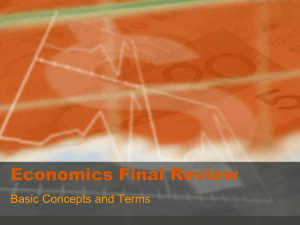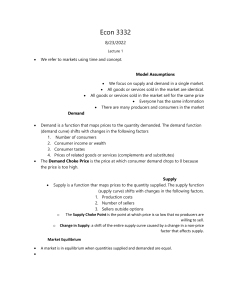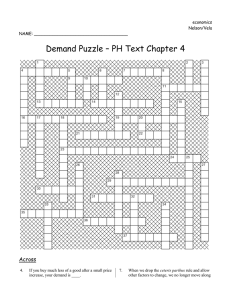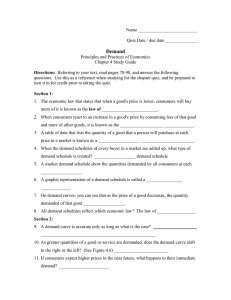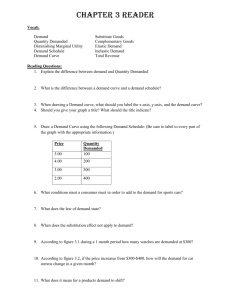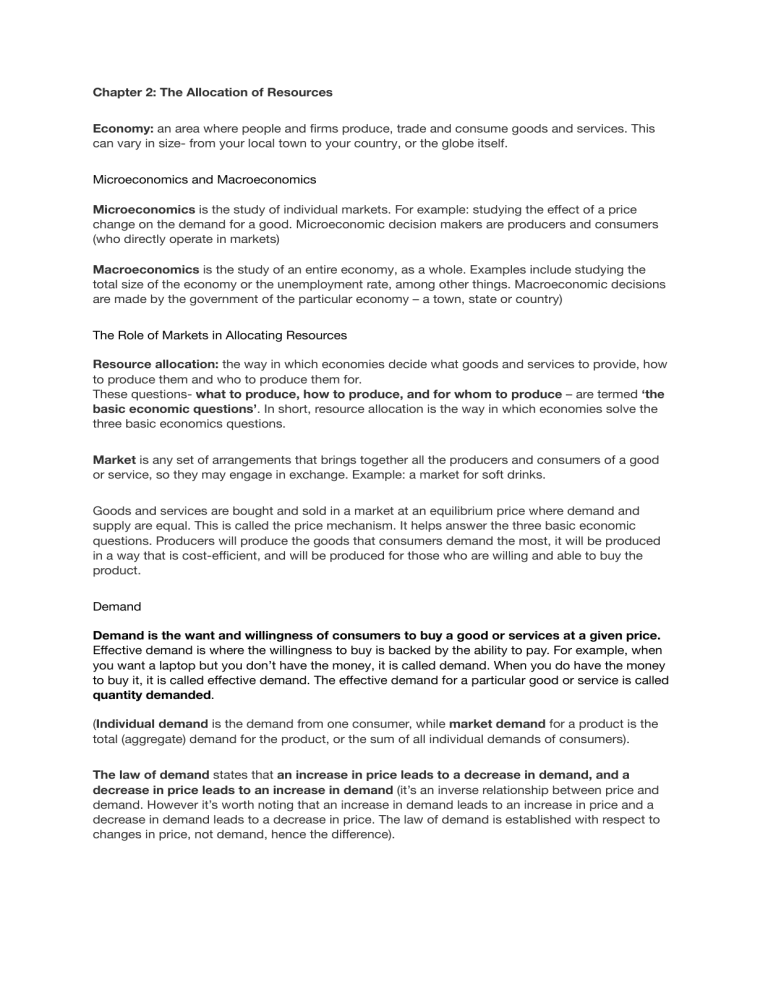
Chapter 2: The Allocation of Resources Economy: an area where people and firms produce, trade and consume goods and services. This can vary in size- from your local town to your country, or the globe itself. Microeconomics and Macroeconomics Microeconomics is the study of individual markets. For example: studying the effect of a price change on the demand for a good. Microeconomic decision makers are producers and consumers (who directly operate in markets) Macroeconomics is the study of an entire economy, as a whole. Examples include studying the total size of the economy or the unemployment rate, among other things. Macroeconomic decisions are made by the government of the particular economy – a town, state or country) The Role of Markets in Allocating Resources Resource allocation: the way in which economies decide what goods and services to provide, how to produce them and who to produce them for. These questions- what to produce, how to produce, and for whom to produce – are termed ‘the basic economic questions’. In short, resource allocation is the way in which economies solve the three basic economics questions. Market is any set of arrangements that brings together all the producers and consumers of a good or service, so they may engage in exchange. Example: a market for soft drinks. Goods and services are bought and sold in a market at an equilibrium price where demand and supply are equal. This is called the price mechanism. It helps answer the three basic economic questions. Producers will produce the goods that consumers demand the most, it will be produced in a way that is cost-efficient, and will be produced for those who are willing and able to buy the product. Demand Demand is the want and willingness of consumers to buy a good or services at a given price. Effective demand is where the willingness to buy is backed by the ability to pay. For example, when you want a laptop but you don’t have the money, it is called demand. When you do have the money to buy it, it is called effective demand. The effective demand for a particular good or service is called quantity demanded. (Individual demand is the demand from one consumer, while market demand for a product is the total (aggregate) demand for the product, or the sum of all individual demands of consumers). The law of demand states that an increase in price leads to a decrease in demand, and a decrease in price leads to an increase in demand (it’s an inverse relationship between price and demand. However it’s worth noting that an increase in demand leads to an increase in price and a decrease in demand leads to a decrease in price. The law of demand is established with respect to changes in price, not demand, hence the difference). This is an example of a demand curve for Coca-Cola. Here, a decrease in price from 80 to 60 has increased its demand from 300 to 500. The increase in demand due to changes in price(without changes in other factors) is called an extension in demand. Here the extension in demand is from A to B. In the above example, an increase in price from 60 to 80, will decrease the demand from 500 to 300. The decrease in demand due to the changes in price (without changes in other factors) is called a contraction in demand. Here the contraction in demand will be from B to A. In this example, there is a rise in the demand of Coca-Cola from 500 to 600, without any change in price. A rise in the demand for a product due to the changes in other factors (excluding price) causes the demand curve to shift to the right (from A to B). In this example, there is a fall in demand for Coca-Cola from 500 to 400, without any change in price. A fall in demand for a product due to the changes in other factors (excluding price) causes the demand curve to shift to the left (from A to B). Factors that cause shifts in a demand curve: ● ● ● ● ● ● ● ● Consumer incomes: a rise in consumers’ incomes increases demand, causing a shift to right. Similarly, a fall in incomes will shift the demand curve to the left. Taxes on incomes: a rise in tax on incomes means less demand, causing a shift to the left; and vice versa. Price of substitutes: Substitutes are goods that can be used instead of a particular product. Example: tea and coffee are substitutes (they are used for similar purposes). A rise in the price of a substitute causes a rise in the demand for the product, causing the demand curve to shift to the right; and vice versa. Price of complements: Complements are goods that are used along with another product. For example, printers and ink cartridges are complements. A rise in the price of a complementary good will reduce the demand for the particular product, causing the demand curve to shift to the left; and vice versa. Changes in consumer tastes and fashion: for example, the demand for DVDs have fallen since the advent of streaming services like Netflix, which has caused the demand curve for DVDs to shift to the left. Degree of Advertising: when a good is very effectively advertised (Coke and Pepsi are good examples), its demand rises, causing a shift to the right. Lower advertising shifts the demand curve to the left. Change in population: A rise in the population will raise demand, and vice versa. Other factors, such as weather, natural disasters, laws, interest rates etc. can also shift the demand curve. Supply Supply is the want and willingness of producers to supply a good or services at a given price. The amount of goods or services producers are willing to make and supply is called quantity supplied. (Market supply refers to the amount of goods and services all producers supplying that particular product are willing to supply or the sum of individual supplies of all producers). The law of supply states that an increase in price leads to an increase in supply, and a decrease in price leads to an decrease in supply (there is a positive relationship between price and supply. However it’s also worth noting that, an increase in supply leads to a decrease in price and a decrease in supply leads to an increase in price. The law of supply is established with respect to changes in price, not supply, hence the difference). This is an example of a supply curve for a product. Here, an increase in price from 60 to 80, has increased its supply from 500 to 700. The increase in supply due to changes in price(without changes in other factors) is called an extension in supply. A decrease in price from 80 to 60, will decrease the supply from 700 to 500. The decrease in supply due to changes in price(without the changes in other factors) is called a contraction in supply. In this example, there is a rise in the supply of a product from 500 to 700, without any change in price. A rise in the supply for a product due to the changes in other factors (excluding price) causes a shift to the right. A fall in supply from 500 to 300, without any changes in price is also shown. A fall in the supply for a product due to the changes in other factors (excluding price) causes a shift to the left. Factors that cause shifts in supply curve: ● ● ● ● ● Changes in cost of production: when the cost of factors to produce the goods falls, producers can produce and supply more products cheaply, causing a shift in the supply curve to the right. A subsidy*, which lowers the cost of production also shifts the supply curve right. When the cost of production rises, supply falls, causing the supply curve to shift to the left. Changes in the quantity of resources available: when the amount of resources available rises, the supply rises; and vice versa. Technological changes: an introduction of new technology will increase the ability to produce more products, causing a shift to the right in the supply curve. The profitability of other products: if a certain product is seen to be more profitable than the one currently being produced, producers might shift to producing the more profitable product, reducing supply of the initial product (causing a shift to the left). Other factors: weather, natural disasters, wars etc. can shift the supply curve left. Market Price The market equilibrium price is the price at which the demand and supply curves in a given market meet. In this diagram, P* is the equilibrium price. Disequilibrium price is the price at which market demand and supply curves do not meet, which in this diagram, is any price other than P*. Price Changes In this diagram, two disequilibrium prices are marked- 2.50 and 1.50. At price 2.50, the demand is 4 while the supply is 10. There is excess supply relative to the demand. When the price is above the equilibrium price, a surplus is experienced. (Surplus means ‘excess’). At price 1.50, the demand is 10 while the supply is only 4. There is excess demand relative to supply. When the price is below the equilibrium price, a shortage is experienced. (This shortage and surplus is said in terms of the supply being short or excess respectively). Price Elasticity of Demand (PED) The PED of a product refers to the responsiveness of the quantity demanded to changes in its price. PED (of a product) = % change in quantity demanded / % change in price For example, calculate the price elasticity of demand of Coca-Cola from this diagram. PED= [(500-300/300)*100] / [(80-60/80)*100] = 66.67 / 25 = 2.67 In this example, the PED is 2.67, that is, the % change in quantity demanded was higher than the % change in the price. This means, a change in price makes a higher change in quantity demanded. These products have a price elastic demand. Their values are always above 1. When the % change in quantity demanded is lesser than the % change in price, it is said to have a price inelastic demand. Their values are always below 1. A change in price makes a smaller change in demand. When the % change in demand and price are equal, that is value is 1, it is called unitary price elastic demand. When the quantity demanded changes without any changes in price itself, it is said to have an infinitely price elastic demand. Their values are infinite. When the price changes have no effect on demand whatsoever, it is said to have a perfect price inelastic demand. Their elasticity is 0. What affects PED? ● ● ● No. of substitutes: if a product has many substitute products it will have an elastic demand. For example, Coca-Cola has many substitutes such as Pepsi and Mountain Dew. Thus a change in price will have a greater effect on its demand (If price rises, consumers will quickly move to the substitutes and if price lowers, more consumers will buy Coca-Cola). Time period: demand for a product is more likely to be elastic in the long run. For example, if the price rises, consumers will search for cheaper substitutes. The longer they have, the more likely they are to find one. Proportion of income spent on commodities: goods such as rice, water (necessities) will have an inelastic demand as a change in price won’t have any significant effect on its demand, as it will only take up a very small proportion of their income. Luxury goods such as cars on the other hand, will have a high price elastic demand as it takes up a huge proportion of consumers’ incomes. Relationship between PED and revenue and how it is helpful to producers: Producers can calculate the PED of their product and take a suitable action to make the product more profitable. Revenue is the amount of money a producer/firm generates from sales, i.e., the total number of units sold multiplied by the price per unit. So, as the price or the quantity sold changes, those changes have a direct effect on revenue. If the product is found to have an elastic demand, the producer can lower prices to increase revenue. The law of demand states that a price fall increases the demand. And since it is an elastic product (change in demand is higher than change in price), the demand of the product will increase highly. The producers get more revenue. If the product is found to have an inelastic demand, the producer can raise prices to increase revenue. Since quantity demanded wouldn’t fall much as it is inelastic, the high prices will make way for higher revenue and thus higher profits. Price Elasticity of Supply (PES) The PES of a product refers to the responsiveness of its quantity supplied to changes in its price. PES of a product= %change in quantity supplied / %change in price Similar to PED, PES too can be categorized into price elastic supply, price inelastic supply, perfectly price inelastic supply, infinitely price elastic supply and unitary price elastic supply. (See if you can figure out what each supply elasticity means using the demand elasticities above as reference, and draw the diagrams as well!) What affects PES? ● ● Time of production: If the product can be quickly produced, it will have a price elastic supply as the product can be quickly supplied at any price. For example, juice at a restaurant. But products which take a longer time to produce, such as cars, will have a price inelastic supply as it will take a longer time for supply to adjust to price. Availability of resources: More resources (land, labor, capital) will make way for an elastic supply. If there are not enough resources, producers will find it difficult to adjust to the price changes, and supply will become price inelastic. Market Economic System In a market economic system or free market economic system, all resources are allocated by the market – private producers and consumers; that is, there is no or very little government intervention in resource allocation. (There are virtually no economies in the world that follow this system – there is government control everywhere, although Hong Kong and Singapore do come close – check out the Index of Economic Freedom to see the ranking of economies on the basis of how market-friendly they are ). Features: ● All resources are owned and allocated by private individuals. ● ● ● ● Government refrains from regulating markets. It instead tries to create very business-friendly environments and any intervention is mostly limited to protecting private property. The demand and supply fixes the price of products. This is called the price mechanism. What to produce is solved by producing the most-demanded goods for which people spend a lot, as their only motive is to generate a high profit. How to produce is solved by using the cheapest yet efficient combination of resources – capital or labor- in order to maximize profits. For whom to produce is solved by producing for people who are willing and able to pay for goods at a high price. Advantages: ● ● ● ● A wide variety of quality goods and services will be produced as different firms will compete to satisfy consumer wants and make profits. Quality is ensured to make sure that consumers buy from them. There is consumer sovereignty. Firms will respond quickly to consumer changes in demand. When there is a change in demand, they will quickly allocate resources to satisfying that demand, so as to maintain profits. High efficiency will exist. Since producers want to maximize profits, they will use resources very efficiently (producing more with less resources). Since there is hardly any government intervention (in the form of regulations, extra fees and fines etc. for example), firms will find it easy and inexpensive to start and run businesses. Disadvantages: ● ● ● ● ● ● ● Only profitable goods and services are produced. Public goods* and some merit goods* for which there is no demand may not be produced, which is a drawback and affects the economic development. Firms will only produce for consumers who can pay for them. Poor people who cannot spend much won’t be produced for, as it would be non-profitable. Only profitable resources will be employed. Some resources will be left unused. In a market economy, capital-intensive production is favored over labor- intensive production (because it’s more cost-efficient). This can lead to unemployment. Harmful (demerit) goods may be produced if it is profitable to do so. Negative impacts on society (externalities) may be ignored by producers, as their sole motive is to keep consumers satisfied and generate a high profit. A firm that is able to dominate or control the market supply of a product is called a monopoly. They may use their power to restrict supply from other producers, and even charge consumers a high price since they are the only producer of the product and consumers have no choice but to buy from them. Due to high competition between firms, duplication of products may take place, which is a waste of resources. *Public goods: goods that can be used by the general public, from which they will benefit. Their consumption can’t be measured, and thus cannot be charged a price for (this is why a market economy doesn’t produce them). Examples are street lights and roads. *Merit goods: goods which create a positive effect on the community and ought to be consumed more. Examples are schools, hospitals, and food. The opposite is called demerit goods which includes alcohol and cigarettes *Subsidies: financial grants made to firms to lower their cost of production in order to lower prices for their products. Market Failure Public goods: goods that can be used by the general public, from which they will benefit. Their consumption can’t be measured, and thus cannot be charged a price for (this is why a market economy doesn’t produce them). Examples include street lights and roads. Merit goods: goods which create a positive effect on the society and ought to be consumed more. Examples include schools and hospitals. The opposite is called demerit goods which include alcohol and cigarettes. External costs (negative externalities) are the negative impacts on society (third-parties) due to production or consumption of goods and services. Example: the pollution from a factory. External benefits (positive externalities) are the positive impacts on society due to production or consumption of goods and services. Example: better roads in a neighborhood due to the opening of a new business. Private costs are the costs to the producer and consumer due to production and consumption respectively. Example: the cost of production. Private benefits are the benefits to the producer or consumer due to production and consumption respectively. Example: the better immunity received by a consumer when he receives a vaccine. Social Costs = External costs + Private Costs Social Benefits = External benefits + Private benefits Market failure occurs when the price mechanism fails to allocate resources effectively. This is the most disadvantageous aspect to the market economy. Causes of market failure are: ● ● ● ● ● ● ● When social costs exceed social benefits (especially where negative externalities (external costs) are high). Overprovision of demerit goods like alcohol and tobacco: the external costs arising from demerit goods are not reflected in the market and so they are overproduced. Under-provision of merit goods such as schools, hospitals and public transport, since the external benefits of these goods are not reflected in the market, they are underproduced. Lack of public goods such as roads, bus terminals and street lights: since their consumption cannot be measured and charged a price for, they are not produced by the private sector. Immobility of resources: when resources cannot move between their optimal uses and thus are not used to the maximum. For example, when workers (labor) don’t have occupational or geographic mobility. Information failure: when information between consumers, producers and the government are not efficiently and correctly communicated. Example: a cosmetics firm advertises its products as healthy when it is in fact not. The consumers who believe the firm and use its products might suffer skin damage. Abuse of monopoly* powers: monopolistic businesses may use their powers to charge consumers a high price and only produce products they wish to, since they know consumers have no choice but to buy from them. *Monopoly: a single supplier who supplies the entire market with a particular product, without any competition. Example: public utilities like water, gas and electricity in many countries are provided by their respective governments with no other producer allowed in the market. Mixed Economic System In a mixed economic system, both the market and government intervention co-exist. Examples include almost all countries in the world (India, UK, Brazil etc.). This is because it overrides all the disadvantages of both the market and planned (govt. only) economies. It identifies the importance of the price mechanism in operating an efficient resource allocation and also the role of the government in correcting (any) market failures. Features: ● ● both the public and the private sector exists planning and final decisions are made by the govt. while the market system can determine allocation of resources owned by it, along with the public organizations. Advantages: ● ● ● ● The govt. can provide public goods, necessities and merit goods. The private businesses can provide profitable and most-demanded goods (luxury goods, superior goods). Thus, everyone is provided for. The govt. will keep externalities, monopolies, harmful goods etc. in control. The govt. can provide jobs in the public sector (so there is better job security). The govt. can also provide financial help to collapsing private organizations, so jobs are kept secure. Disadvantages: ● ● ● Taxes will be imposed, which will raise prices and also reduce work incentives. Laws and regulations can increase production costs and reduce production in the economy. Public sector organizations will still be inefficient and will produce low quality goods and services. The specific ways in which the government, in a mixed economic system, can correct market failures of the market: ● Legislation and regulation – the government can make laws that regulate market activity, for example, prohibit smoking in public (which would cause a negative externality). One important kind of legislation the govt. can undertake price controls – setting a minimum price or maximum price on goods. Minimum price or price floor is set to control a decreasing tendency of price. The minimum wage laws in many countries are an example of minimum price. The government sets the minimum wage above the existing market equilibrium wage, to ensure that all workers get a basic minimum wage to sustain them. But even as low-income workers now get better wages, the higher wage will cause the demand for labor to contract, as shown in the diagram to the left. There will also be a higher supply of labor (workers who want work) because of higher wages. A reduced demand and increased supply will cause excess supply of labor i.e., unemployment. Maximum price or price ceiling is set to control an increasing tendency of price. It is usually set on rent (this is called rent control), to ensure that low-income tenants can afford to rent homes. But as a result of the lower rent, landlords will stop renting more homes, causing supply to contract, as shown in the diagram to the left. At the same time, lower rent will increase the demand for homes. A reduced supply of homes and higher demand for them will cause a shortage of supply in relation to demand. ● ● Direct provision of merit and public goods – since there is little incentive for the price mechanism to supply these goods, governments usually provide them. For example, free education, free healthcare, and public parks. One way the govt. can do this by nationalizing certain products it considers essential to be provided by a governing authority, rather than the market. For example, in India, the government operates the only railway network because only it can provide cheap services to its millions of poor, daily passengers. Taxation on products – imposing a tax on products (indirect taxes) with negative externalities can discourage its production and consumption. For example, a tax on tobacco will make it expensive to produce and consume. In the diagram below, a tax has been imposed on a product, causing its supply to shift from S to S1. The price rises from P to P1 because of the additional tax amount, and the quantity traded in the market falls from Q to Q1. Subsidies – a subsidy is a grant (financial aid) on products that have a positive externality. Subsidizing, for example, cooking gas for the poor, will increase the living standard of the population. In the diagram below, a subsidy has been imposed on a good, causing its supply to shift from S to S1. It results in a fall in price from P to P1 and subsequently, an increase in the quantity traded in the market from Q to Q1. ● ● ● ● *Note: movements along a demand or supply curve of a good only happen as a result of a direct change in price of the good; changes caused by any other factor, tax and subsidy included, is represented by a shift in the curves. Tradable permits – firms will have to buy permits from the government to do something, for example, pollute at a certain level, and these can be traded among firms. Since permits require money, firms will be encouraged to pollute less. Extension of property rights – one of the main reasons for pollution in public spaces is that it is public – it does not harm a specific private individual – the resource is the government’s who cannot charge compensations easily. So the government can extend property rights (right to own property) of public places to private individuals. This will effectively privatize resources, create a market for these spaces and then individuals can be fined for polluting International cooperation among governments – governments work together on issues that affect the future of the environment. As you can see, market failure can be corrected by governments in a variety of ways and the presence of a government is quite indispensable in any modern economy. Planned (government-only) economies are too inefficient and free market (no government) economies result in market failures. So a mixed economic system tries to balance both sides. That being said, there are certain drawbacks to government intervention in an economy. ● ● ● ● Political incentives: this occurs when there is a clash between politics and economics (because a government is a political entity with political incentives). For example, even though mining companies cause a lot of environmental damage, the government may encourage and promote their activities to garner political and financial support from them. Lack of incentives: in the free market, individuals have a profit incentive to innovate and cut costs, but in the public sector, such an incentive is absent since the government will pay them salaries regardless of their performance. So, even as the government provides certain public and merit goods directly to the people at low costs, they tend to be very inefficient. Time lags, information failure: these are some of the government failures arising because of a lack of incentive. Government offices and employees don’t have an incentive to provide timely services or give accurate information and this leads to very inefficient systems. Welfare effects of policies: government policies such as taxation and welfare payments distort the market. This means that such policies will influence demand and supply in the economy and cause markets to move away from the efficient points produced by a market system. For example, high corporate taxes will deter companies from expanding their operations and making more profits or deter new enterprises from entering the market. Unemployment benefits given out by the government may cause people to stay unemployed and receive free benefits instead of working.

